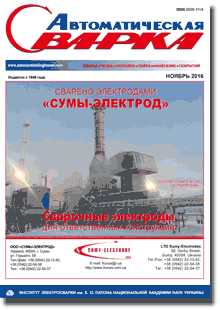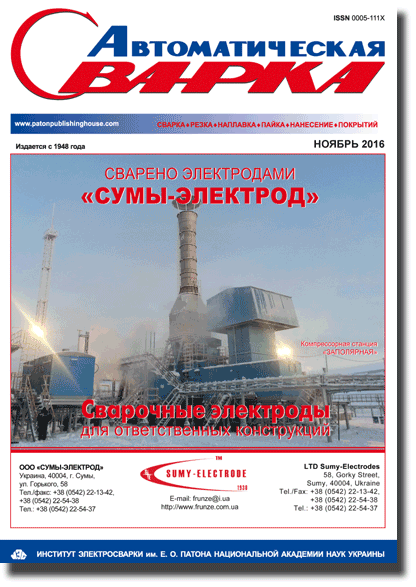| 2016 №11 (04) |
DOI of Article 10.15407/as2016.11.05 |
2016 №11 (06) |

Avtomaticheskaya Svarka (Automatic Welding), #11, 2016, pp. 35-39
Effect of laser radiation absorption on efficiency of laser welding of copper and its alloys
V.Yu. Khaskin1, 2, V.N. Korzhik1, 2, T.G. Chizhskaya3, V.N. Sidorets2 and Lo Zie1
1Guangdong Welding Institute (Chinese-Ukrainian E. O. Paton Institute of Welding) Guangzhou, China
2E.O. Paton Electric Welding Institute, NASU 11 Kazimir Malevich Str., 03680, Kiev, Ukraine. E-mail: office@paton.kiev.ua
3NTUU «Igor Sikorsky Kyiv Polytechnic Institute» 37 Pobedy Ave., Kiev-56, Ukraine
Abstract
Due to a high reflection power of copper it is usually assumed that the laser welding of products of this material is not rational. However, in the modern industry the problems of joining the parts of copper and its alloys periodically arise, applying narrow welds with a deep vapor-gas channel. Moreover, for technical reasons the use of electron beam welding is not always possible and a sufficiently wide availability of fiber (wavelength of 1.07 μm) and disc (wavelength of 1.03 μm) industrial lasers of the latest generation makes the problem of laser welding of these materials challenging. Therefore, the aim of the work was to study the conditions of absorbing the laser radiation with the wavelength of 1.03–1.07 μm by copper and its alloys in laser welding with a deep penetration, as well as to determine the basic parameters of the welding mode and to evaluate the process effectiveness. It was shown in the work that for certain combinations of thickness of copper alloy and density of radiation power with the wavelength of 1.03–1.07 μm, the optimal speed of welding process exists, at which its technical and economic efficiency is maximum. This speed should be such that the absorbing capacity (integrated over the spot of laser heating) can be at the level of about 13–15 %. The exceeding of welding speed leads to a sharp decrease in absorbing capacity, and, consequently, to the need in increasing the radiation power and growing the cost of the process. The decrease in welding speed relatively to the optimal one leads to decrease in efficiency, overheating of metal in the weld pool and to such defects of weld shaping, as sagging and metal splashes. 11 Ref., 8 Figures.
Keywords: laser welding, copper, solid-state laser radiation, absorbing factor, radiation power, welding speed
Received: 11.10.16
Published: 14.12.16
References
- Grigoryants, A.G., Shiganov, I.N. (1988) Laser equipment and technology. Book 5: Laser welding of metals. Manual for inst. of higher education. by A.G. Grigoryants. Moscow: Vysshaya Shkola.
- Bernadsky, V.N., Shelyagin, V.D., Makovetskaya, O.K. (2007) Present market of laser equipment for welding and processing of materials. The Paton Welding J., 10, 44–49.
- Noskov, M.M. (1983) Optical and magnetooptical properties of metals. Sverdlovsk: UNTs AN SSSR.
- Kiselev, A.I., Akashev, L.A., Kononenko, V.I. (2004) Effective mass of electrons in melts of aluminium, cesium and Al–3 at.% Ce binary system. Tekhnicheskoj Fiziki, 74(Issue 3), 20–23.
- Zinoviev, V.E. (1989) Thermophysical properties of metals at high temperatures: Refer. Book. Moscow: Metallurgiya.
- Ujihara, K. (1972) Reflectivity of metals at high temperatures. of Applied Physics, 43(5), 2376–2383. https://doi.org/10.1063/1.1661506
- Ordal, M.A., Long, L.L., Bell, R.J. et al. (1983) Optical properties of the metals Al, Co, Cu, Au, Fe, Pb, Ni, Pd, Pt, Ag, Ti and W in the infrared and far infrared. Applied Optics, 22(7), 1099–1119. https://doi.org/10.1364/AO.22.001099
- Miller, J. (1969) Optical properties of liquid metals at high temperatures. Mag., Vol. 20, 12(Issue 168), 1115–1132. https://doi.org/10.1080/14786436908228198
- Comins, N.R. (1972) The optical properties of liquid metals. Ibid., 25(Issue 4), 817–831. https://doi.org/10.1080/14786437208229306
- Khaskin, V.Yu. (2012) Experiment-calculated method for determination of conditions of laser surfacing processes. Nauka ta Innovatsii, 8(6), 5–16. https://doi.org/10.15407/scin8.06.005
The cost of subscription/purchase order journals or individual articles
| Journal/Currency | Annual Set | 1 issue printed |
1 issue |
one article |
| TPWJ/USD | 384 $ | 32 $ | 26 $ | 13 $ |
| TPWJ/EUR | 348 € | 29 € | 24 € | 12 € |
| TPWJ/UAH | 7200 UAH | 600 UAH | 600 UAH | 280 UAH |
| AS/UAH | 1800 UAH | 300 UAH | 300 UAH | 150 UAH |
| AS/USD | 192 $ | 32 $ | 26 $ | 13 $ |
| AS/EUR | 180 € | 30 € | 25 € | 12 € |
| SEM/UAH | 1200 UAH | 300 UAH | 300 UAH | 150 UAH |
| SEM/USD | 128 $ | 32 $ | 26 $ | 13 $ |
| SEM/EUR | 120 € | 30 € | 25 € | 12 € |
| TDNK/UAH | 1200 UAH | 300 UAH | 300 UAH | 150 UAH |
| TDNK/USD | 128 $ | 32 $ | 26 $ | 13 $ |
| TDNK/EUR | 120 € | 30 € | 25 € | 15 € |
AS = «Automatic Welding» - 6 issues per year;
TPWJ = «PATON WELDING JOURNAL» - 12 issues per year;
SEM = «Electrometallurgy Today» - 4 issues per year;
TDNK = «Technical Diagnostics and Non-Destructive Testing» - 4 issues per year.





